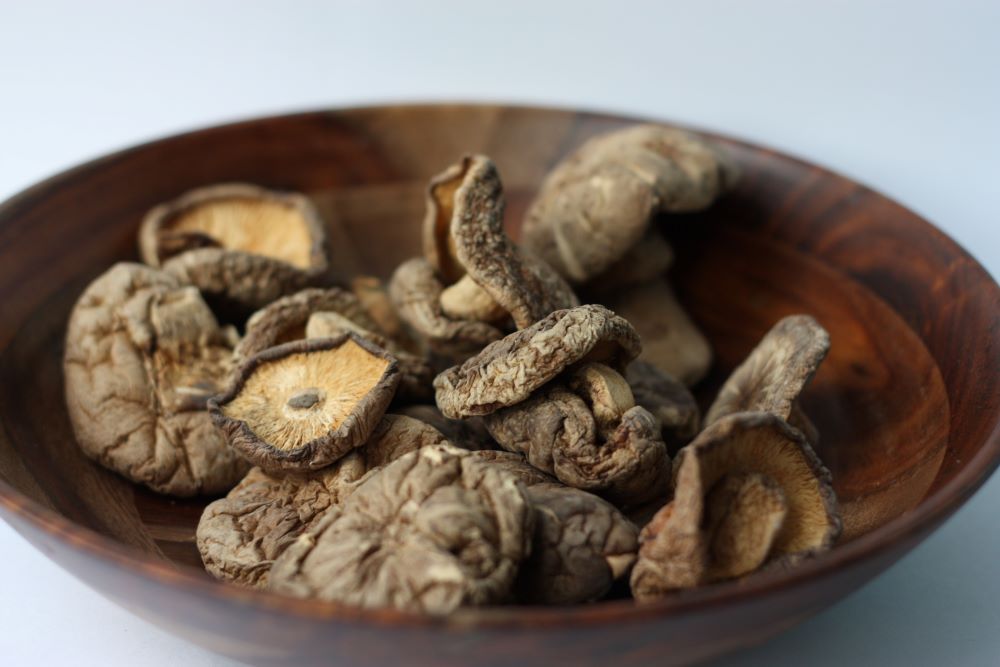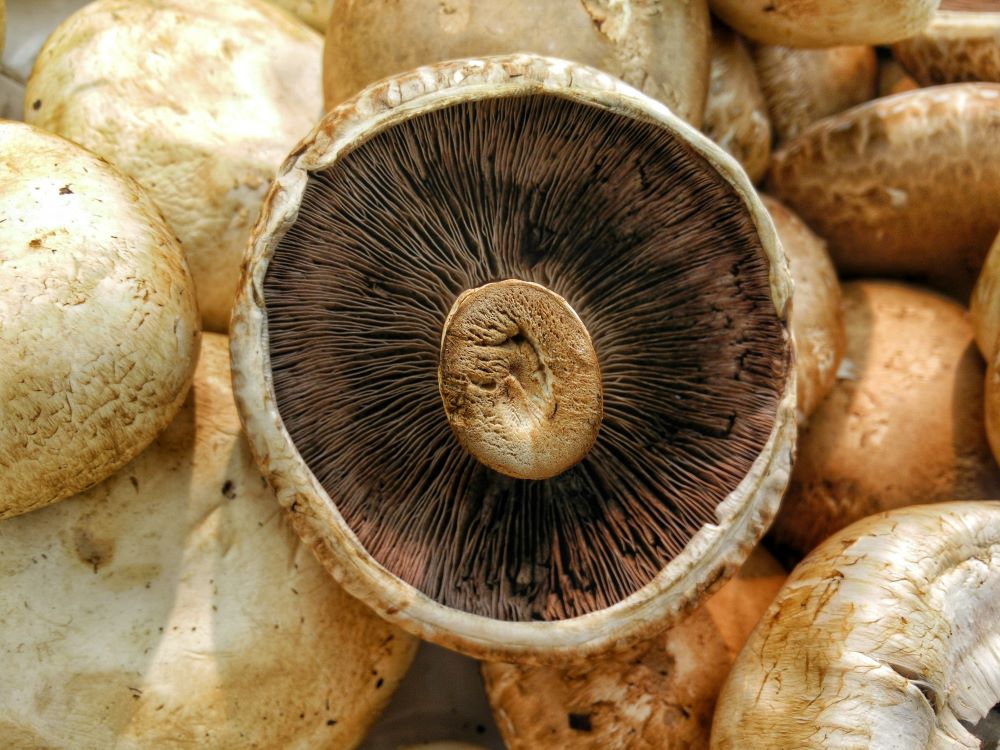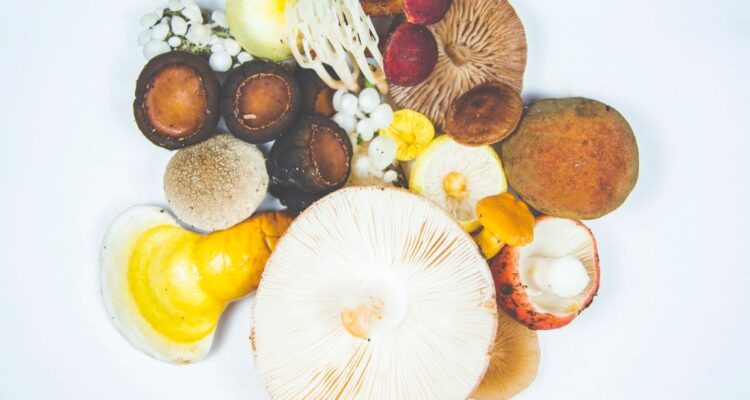Mushrooms contain protein and are even occasionally used to substitute meat because of their texture and flavour. But do they provide enough for a balanced diet and which ones offer the most?
The seven mushrooms that contain the most protein are oyster mushrooms, white button mushrooms, morels, portobello, enoki, shiitake and maitake mushrooms. While you’d need to eat vast amounts to fulfil your daily needs, they’re a useful protein source and have various additional benefits.
Mushrooms vary in protein content, depending on their type, where they have been cultivated, and how they have been processed. Depending on which mushrooms you are using and how you are using them will determine the amount of protein they give you. With some basic information, you should be able to quickly identify several of the mushrooms with the highest protein content.
Table of Contents
Protein Content of Mushrooms
One hundred grams of mushrooms only provides between four and seven per cent of daily protein values, so you would have to eat a great many of them to meet your protein needs. The British Nutrition Foundation’s recommended consumption of daily protein is dependent on your weight, but it can be summarised as ‘approximately 56g/day and 45g/day for men and women aged 19-50 years respectively’.
To get this amount solely from mushrooms, you would need to eat nearly two kilograms per day. While you can’t rely on mushrooms as your only protein source, they’re still an excellent addition to your diet.They’re particularly useful in vegan or vegetarian diets because mushroom proteins are rich in leucine and lysine, which aren’t present in many other plant-based foods.
Whether you’re vegan or not, to ensure that you get enough of all necessary amino acids, it’s crucial that your diet includes a variety of different protein sources. This means that in order to meet your daily needs, mushrooms are best eaten alongside other protein-rich foods such as bean sprouts, chickpeas, peanuts, lentils, soybeans, tofu, eggs, meat and fish.
Factors Affecting Protein Content of Mushrooms
Protein content differs not only between mushroom types but also between mushroom species. For example, within the oyster mushroom family, the Pleurotus sajor-caju species contains more protein than Pleurotus florida. They both have more protein than the Pleurotus-eous species.
The level of protein a mushroom contains is affected by its stage of maturity when it is harvested and the environmental factors where it is grown. If mushrooms are produced in a polluted area, they can absorb the toxins from the environment, which affect their growth and nutritional value. Processing methods can also reduce the protein content in mushrooms. For instance, overheating them will denature the proteins they contain. A cooked mushroom is likely to have only half the protein content it did when raw.
The Most Protein Rich Mushrooms
The seven mushrooms that contain the most protein ranked from highest to lowest are:
| Protein Source (Raw Mushrooms) | Protein per 100g serving |
| Oyster mushrooms | 3.4g |
| White button mushrooms | 3.1g |
| Morel mushrooms | 3.1g |
| Portobello mushrooms | 3.1g |
| Enoki mushrooms | 2.7g |
| Shiitake mushrooms | 2.2g |
| Maitake Mushrooms | 1.9g |
| Other Protein Sources | Protein per 100g serving |
| Baked beans | 6g |
| Lentils | 9g |
| Chickpeas | 19g |
| Duck | 19g |
| Pinto beans | 21g |
| Pork loin | 26g |
| Skirt steak | 26g |
| Chicken | 27g |

1. Oyster Mushrooms
Oyster mushroom is the common name for the species Pleurotus ostreatus. In the wild they grow on or near trees and can be found in forests in the UK and across the world. Oyster mushrooms are also one of the most commonly cultivated mushrooms worldwide.
Also known as pearl oyster mushrooms and tree oyster mushrooms they can be eaten raw but have a rather metallic taste so tend to be eaten cooked. They can also be dried. 100g of raw oyster mushrooms contains 3.4g of protein but this is about halved once they are cooked. Oyster mushrooms have a mild, savoury flavour, are common in cooking and widely available to buy.
- Species name: Pleurotus ostreatus, also know as pearl or tree oyster mushrooms
- Mild, savoury flavour
- Best eaten cooked
- Protein content of 3.4g per 100g raw, halved after cooking
- Widely available
2. White mushrooms
The scientific name for white mushrooms is Agaricus bisporus. They are also known as button mushrooms, champignon, table mushrooms and common mushrooms and they are the most commonly eaten and cultivated mushrooms in the world. White mushrooms are harvested when the fungi are still immature.
They can be eaten raw or cooked and have a mild, fresh flavour. 100g of raw white mushrooms contains 3.1g of protein. This reduces when cooked so to benefit from their full protein content, eat them raw.
- Scientific name: Agaricus bisporus, also known as button mushrooms, champignon, table mushrooms and common mushrooms
- Mild, fresh flavour
- Can be eaten raw or cooked
- Protein content of 3.1g per 100g when raw
- Widely available
3. Morels
Morels grow wild in the northern hemisphere. They cannot be cultivated on mushroom farms like white button mushrooms and oyster mushrooms, so they must be harvested from the wild. This also means they are seasonal, but they can be dried or frozen.
Morels should always be cooked before eating as they can cause an upset stomach if eaten raw. A rich, earthy flavour make them enjoyable on their own or in a dish. 100g of raw morels contains 3.1g of protein, offering about 1.5g when cooked. Morels also have the highest amount of vitamin D out of all the edible mushrooms.
- Rich, earthy flavour
- Must be cooked before they are eaten
- 100g of raw morels contains 3.1g of protein resulting in 1.5g when cooked
- Seasonal but they can be frozen or dried
4. Portobello

The scientific name for Portobello mushrooms is Agaricus bisporus, the same as white mushrooms. When white mushrooms mature, they turn browner in colour and are known as portobello mushrooms. Like their smaller relatives, these mushrooms are widely cultivated.
Large, flat and open, portobello mushrooms are sometimes referred to as steak mushrooms. Raw, they contain 3.1g of protein for every 100g. It is advisable to eat these mushrooms cooked and so the protein content will roughly be have the raw value.
- Scientific name: Agaricus bisporus, also known as steak mushrooms
- Rich, meaty flavour
- Best to eat them cooked
- Raw protein content is 3.1g per 100g, which is about halved when cooked
5. Enoki
Enoki mushrooms can also be referred to as winter mushrooms, golden needle mushrooms and lily mushrooms, They have small creamy white caps and long slender stems and are usually sold in clusters. Growing in the wild in Asia, they have a winter season but cultivation means they are available all year round.
They can be eaten raw but are more commonly lightly cooked. They have a mild, sweet flavour and a soft, noodle-like texture. 100g of raw Enoki contains 2.7g of protein but this is halved once they are cooked.
- Also known as winter, golden needle and lily mushrooms
- Mild, sweet flavour and noodle-like texture when cooked
- Can be eaten cooked or raw
- Raw protein content is 2.7g per 100g, which is about halved when cooked
6. Shiitake
Shiitake mushrooms are probably the most well-known of the oriental mushrooms, growing natively in East Asia on the shii tree. They have a deep, rich, meaty flavour and a denser texture than some other mushrooms. The flavour is further intensified when the mushrooms are dried. Dried shiitake mushrooms need reconstituting in water before using.
If using fresh, the stalk is usually removed as it can be a bit tough, but the rest of the mushroom can be eaten raw as well as cooked. 100g of raw shiitake mushrooms contains 2.2g of protein, providing just over 1g per 100g when cooked.
- Deep, rich, meaty flavour
- Commonly available dried, but can also be found fresh
- Can be eaten raw or cooked.
- Dried shiitake must be reconstituted in water before using
- Just over 1g of protein per 100g when cooked, 2.2g when raw
7. Maitake
Maitake mushrooms grow in the wild on old or decaying wood but are also widely cultivated in China and Japan. They are commonly known as hen-of-the-woods and have a frilly, flower-like structure. Maitake mushrooms have a more complex flavour than some other mushrooms, some even saying there is a hint of warm spice to it.
You can eat maitake mushrooms raw, although older ones can be a bit tough so it is best to go for younger ones if you want to eat them raw. However, they’re not the easiest to get hold of fresh, so you are more likely to find them dried and these will need reconstituting before cooking them. 100g of raw maitake mushrooms contains 1.9g of protein which about halves when cooked.
- Also known as hen-of-the-woods
- A complex, meaty flavour perhaps with a hint of spice
- Can be eaten raw or cooked
- More widely available dried, which need reconstituting before use
- 1.9g of protein per 100g when raw
Conclusion
All edible mushrooms have health benefits, and as the body of research around them grows, their dietary and medicinal value is becoming increasingly apparent to modern science. In addition to high-quality proteins, they offer additional nutritional benefits as they are good sources of iron and Vitamins B and D. Even if you are not vegan or vegetarian, mushrooms are a valuable part of a healthy diet.
My Supplement Recommendations
These are products that I currently use and enthusiastically recommend:
Multivitamin – Nutrigenesis Multi for Men or Nutrigenesis for Women. Performance Lab use their patented Nutrigenesis technique to provide a range of vitamins and minerals in their most effective form. Read my review.
Nootropic – Mind Lab Pro contains eleven natural nootropics that have been proven to support cognitive function and brain health. Read my review.
Collagen – Edible Health Bovine Collagen. This excellent bovine collagen powder is completely tasteless and absorbs quickly into any liquid. It’s third-party lab tested and provides 13g of collagen per serving. Read my review.
Turmeric – VitaBright Organic Turmeric with Ginger and Black Pepper. These turmeric capsules are organic, effective and affordable. They include black pepper to enhance curcumin absorption and ginger to provide additional useful benefits. Read my review.
Incredible value – G&G Vitamin 28 day packs This is the most affordable way to buy supplements in the UK. One tub holds 28 daily packs of up to 11 different vitamins, minerals or food supplements.
Related reading
You may also be interested in reading Mushrooms 4 Life My Complex Capsules Review, The Incredible Benefits of Mushrooms, Best Mushroom Supplements UK and What Are the Benefits of Lion’s Mane Mushroom?
For vegan products, check out: Where to find vegan food online.
If you’re looking for supplements, vitamins, minerals or just some helpful information, we have some other lists that you may find useful.
- All vitamin and mineral lists
- Best Collagen Supplements UK
- Turmeric Supplements
- Best Ashwagandha
- Best Multivitamins
- Nootropic Supplements
- Best Mushroom Supplements
- Greens Blend Supplements UK
This site is a participant in affiliate advertising programs designed to provide a means for sites to earn advertising fees by advertising and linking to products and services. We participate in programs from Amazon, eBay, CJ, Awin, Viglink and other sites. We are compensated for referring traffic and business to companies linked to on this site.

